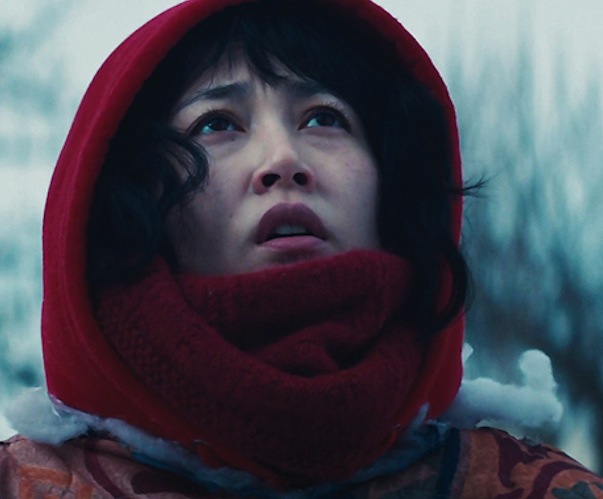Film Review: “Kumiko, the Treasure Hunter” — American Surrealism
.The Zellner brothers’ excellent film is inspired by a Japanese urban legend of a young woman who came to America supposedly because of Fargo, and then committed suicide in the snows.
Kumiko, the Treasure Hunter, directed by David Zellner. At the Kendall Square Cinema, opening on March 27.

A scene from “Kumiko, the Treasure Hunter.”
By Gerald Peary
Is it an actual dream, a wish fulfillment daydream, or does this scene really happen in some alternate, surrealist, buccaneer filmic universe, also occupied by such enchantments as Luis Bunuel’s Adventures of Robinson Crusoe and Raul Ruiz’s Treasure Island? Kumiko, the Treasure Hunter opens unexpectedly on a paradisal beach, where our soon-to-be heroine digs in the sand, explores a cave, and comes up with as prized booty–why not–a VHS copy of the Coen Brothers’ classic Fargo. The Holy Grail!
The film catapults to Komiko’s squat Tokyo apartment, where she checks out her found videotape, avidly watching it on a small TV. It’s woefully battered and damaged, maybe fourth-generation Fargo. But speed through the 1996 neo-noir, and it reveals its magical message about an hour in. That’s when a bleeding Steve Buscemi parks his automobile, takes piles of kidnapping-raised money out of his glove department, throws the green stuff into a tiny valise. He leaves his car, stumbles into a field, and hides the valise in the deep snow by a barbed-wire fence.
Suddenly, Kumiko has a reason to live: there’s buried treasure in the winter land of Fargo, North Dakota! $$$$$$! She’s going to get there, she tells a Buddha look-alike library guard, because she sees herself as a Spanish conquistador–one on the way to El Dorado.
Austin, Texas’s talented Zellner Brothers (David directed, he and Nathan co-wrote) made half the film in Tokyo, half in Minnesota. The Japanese section is shot formally, in the austere style of a Japanese art movie. And it has a very Japanese theme: an individualist protagonist, Kumiko (Rinko Kikuchi), choking to express her inner self in a society of oppressive conformity. Yes, Kumiko has one of those hopeless office jobs, a cog in an all-female work force who wear matching plaid vests and blouses with big bows, and who squeal over lunch hour because one of them has permed her eyebrows. Naturally, the boss is a middle-aged man, a smug sexist and a bit of a lech. He makes Kumiko take his suits to the cleaners and orders her to buy a present for his wife on their anniversary.
Escaping her employ isn’t much better, as she keeps running into an old classmate, annoyingly cheery with one of those grating, lilting feminine voices. And finally, home means persistent phone calls from her nosy, critical mom: “Are you getting a promotion? Are you dating anyone? When will you move back with your mother?”Kumiko’s only joy: the companionship of Bunzo, her pet rabbit. Oh, and that Fargo tape, beckoning her abroad.
In what I assume is an homage to Psycho, Kumiko makes like Janet Leigh’s Marion Crane’s stealing her boss’s money and running. Kumiko utilizes her boss’s company credit card to put herself on a plane, Tokyo to Minneapolis. But not before spitting in his cup of tea, and throwing his cleaned suits in the trash. So disrespectful and un-Japanese!
Surrealism is about the eerie jolt of unexpected juxtapositions, and it can occur in cinema with foreigners trekking through the strange land of the US of A. Recall the Japanese and Italian tourists in Memphis in Jim Jarmusch’s Mystery Train, the German wandering from American motel to motel in Wim Wenders’s Alice in the City, or weird Bruno S. on the road in Werner Herzog’s Stroszek. Add Kumiko to this mix, encountering one oddball midwesterner after another once she lands at the Minneapolis airport. However, as she travels north by north, Kumiko is barely interested in whom she meets, or grateful for their friendship. She has only one care, one obsession, and that’s getting herself to Fargo. As she steps into the whiteout terrain of Northern Minnesota and Northern North Dakota, the skillful camerawork of Kumiko the Treasure Hunter comes to emulate Roger Deakins’s haunting cinematography for the Coen Brothers. Credit Sean Porter, Kumiko’s great DP.
The Zellner brothers’ excellent film is inspired by a Japanese urban legend of a young woman who came to America supposedly because of Fargo, and then committed suicide in the snows. There was such a woman, she did kill herself, but it had nothing to do with a movie, everything to do with her ex-American boyfriend. A suicide? Fortunately, the Zellners have better plans for their heroine in Kumiko’s delirious, wonderfully improbable, and probably surrealistic, ending. For which Kumiko, for the first time, is wearing makeup and red lipstick.
Gerald Peary is a professor at Suffolk University, Boston, curator of the Boston University Cinematheque, and the general editor of the “Conversations with Filmmakers” series from the University Press of Mississippi. A critic for the late Boston Phoenix, he is the author of 9 books on cinema, writer-director of the documentary For the Love of Movies: the Story of American Film Criticism, and a featured actor in the 2013 independent narrative Computer Chess.
